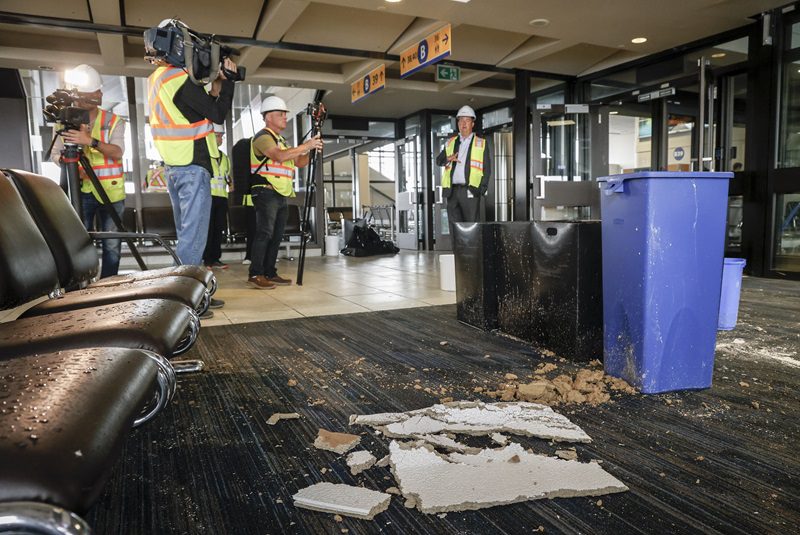Will Calgary hailstorm rival 2020’s $1.2 billion event?

A massive hailstorm that struck Calgary Aug. 5 resembles a storm in the city several years ago that cost Canadian P&C insurers about $1.2 billion in insured damage, according to the Northern Hail Project (NHP).
“Preliminary findings indicate that the scope of damage for this event is like that from the 2020 storm,” says an article in Western News, a publication from Ontario’s Western University, which founded NHP in 2022. “The main difference being that this time the International Airport (and aircraft on the ground) sustained noteworthy damage.”
The Calgary Airport Authority says the intense rain and hailstorm caused “significant water damage to part of its terminal” and had a “major impact on operations.” Calgary-based WestJet also cancelled flights and grounded 16 aircraft with significant hail damage.
Claims adjusters are seeing many commercial and residential property claims, Dustin Volk, senior vice president of operations with ClaimsPro, told Canadian Underwriter Monday. Severity ranges from minor to major damage — broken windows, torn roofs, cracked siding, internal flooding and other damage caused by a breach in structure or opening in the structure from hail.
The Weather Network reported early estimates suggest “at least 35,000 homes” in northern Calgary and the immediate area were damaged to some degree by the storm.
“We are also receiving very significant and complex commercial losses impacting business operations and publicly accessed areas,” Volk says. “Severity is primarily moderate in scale on average, but as noted above we are seeing a mix, which includes some very significant damage in the tens of millions.”
David Repinski, CEO of CRU Group, says hail caused considerable damage to homes, buildings and cars throughout the Calgary region. “We are in the process of inspecting hundreds of properties and facilitating the desk processing of numerous auto and homeowner claims.”
Judging from photos posted on social media, there was extensive damage to unprotected vehicles — mostly to glass, but also to body panels, adds Glenn McGillivray, managing director of the Institute for Catastrophic Loss Reduction.
“On the residential side, there was also damage to roofs and siding, as well as to windows and other details,” he says. “On the commercial side, there was likely damage to roof-top [units such as] HVAC systems. Damage could also have been experienced to vehicle fleets (new and used cars, rental fleets and corporate service fleets) not under cover.”
Milder than 2020?
McGillivray says it’s hard to tell at this point if this event will exceed $1 billion in insured losses. He says damage pictures he’s seen from the 2024 event seemed milder than those from 2020, which he could tell would be a record-breaker for damage.
“One thing to note is that Calgary Airport experienced damage, including damage to jet airliners,” McGillivray says. “This may drive the numbers up.”
NHP continues to survey hail damage, including rural areas around Calgary that also received damage during the storm. This is the first time an in-depth investigation has been undertaken following a significant urban hail event in Canada, NHP adds.
The extent of damage and largest hail size is still being determined, NHP says. So far, ping pong to golf ball-sized hail has been found, “unlike 2020, when stones the size of softballs and grapefruit were reported,” McGillivray says.
According to Western News, the storm formed west of Cochrane, Alta. before passing over Calgary. The hail swath was more than 120 kilometres long and 12 kilometres wide, and strong winds appeared to play a role in increasing damage.
McGillivray says the hail swath, “while not way outside the ordinary…was pretty significant. One thing that made this event different is that two supercells (one impacting north Calgary and the other impacting Okotoks and areas east) caused two separate hail damage swaths.”
This latest severe weather event is one of numerous around the country recently, including flooding in Toronto, remnants of Hurricane Debby in Quebec and the Jasper, Alta. wildfires.
How does this affect adjuster capacity?
“Adjuster capacity is definitely impacted with what appears to be a cascading Cat event season with multiple events happening across the country every week over the last month,” Volk says.
“The good news is we prepare for Cat season in advance by having adjuster teams ready to mobilize on scene as required, with back up and additional support from remote adjusters with the required licensing. The regulators have also been helpful with escalating licensing to ensure we can quickly assign additional capacity from other regions.”
Feature image: Chris Miles, right, Chief Operating Officer, of the Calgary Airport, speaks to members of the media on a tour of a closed concourse as repairs are underway at the Calgary International Airport after parts of its domestic terminal building were closed late Monday due to damage caused by hail and heavy rainfall, in Calgary, Alta., Tuesday, Aug. 6, 2024. THE CANADIAN PRESS/Jeff McIntosh



